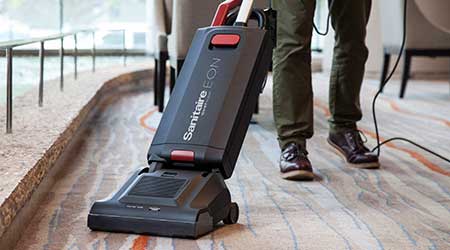 Sponsored Learning - what is this?
Sponsored Learning - what is this?5 Insights When Evaluating Cleaning Equipment
With the array of tools now available on the market, selecting the proper equipment for the job plays an increasingly important role in determining whether a cleaning business can become successful. Equipment that helps crews clean larger areas faster, reduces or eliminates interruptions caused by breakdowns or to replace parts can improve productivity and profit, which, in turn, reduces the cost of owning the equipment.
Easy assembly and maintenance: Look for equipment that can be assembled or maintained with no tools. Look for equipment such as upright vacuums that have easily accessible ports for removing clogs, or easy access doors to easily remove and replace bags, brushrolls and filters. The faster these tasks can be accomplished, the faster the workers can complete their assignments.

CRI Certification: Vacuums approved by the Carpet and Rug Institute have been subjected to testing that proves they are highly effective at removing soil, improving the appearance of carpet and protecting the texture of carpet. Certification also requires the vacuums exhaust minimal levels of dust and allergens.
Consider LEED Approved Green Cleaning Equipment: A rapidly rising number of Class A office buildings, schools and health care facilities are seeking to acquire and maintain LEED certification. Using LEED-approved cleaning equipment can help buildings fulfill certification requirements. LEED-approved equipment requires vacuums and extractors have the Carpet and Rug Institute Seal of Approval. In addition, all equipment should have ergonomic designs, bumpers to protect building surfaces and operate at 70 decibels or less.
Day Cleaning: Contractors whose equipment meets LEED requirements may also be able to shift building cleaning from night to day and enhance the LEED ratings of buildings. The U.S. Environmental Protection Agency encourages day cleaning because it reduces the amount of energy required to light, heat, or cool buildings at night. Consultants have estimated energy savings ranging from 0.6 to 8 percent by switching janitorial work from night to day.
Weight Distribution: Equipment should be designed with a low-weight at the handle and more weight at the base. The lighter the handle weight, the less strain will be placed on workers' arms, lower backs and shoulders. That lower weight also makes it easier and faster for workers to operate equipment in tight spaces.
What Is Sponsored Learning?
CleanLink sponsored learning allows marketers to connect with our cleaning professional audience by allowing them to deliver educational content on our CleanLink publishing platform.
Sponsored learning pieces are provided by the marketer.

 The Down and Dirty on Cleaning in Virus Season
The Down and Dirty on Cleaning in Virus Season How Surfactant Use is Expanding in Commercial Cleaning
How Surfactant Use is Expanding in Commercial Cleaning Clean Buildings Conference
Clean Buildings Conference